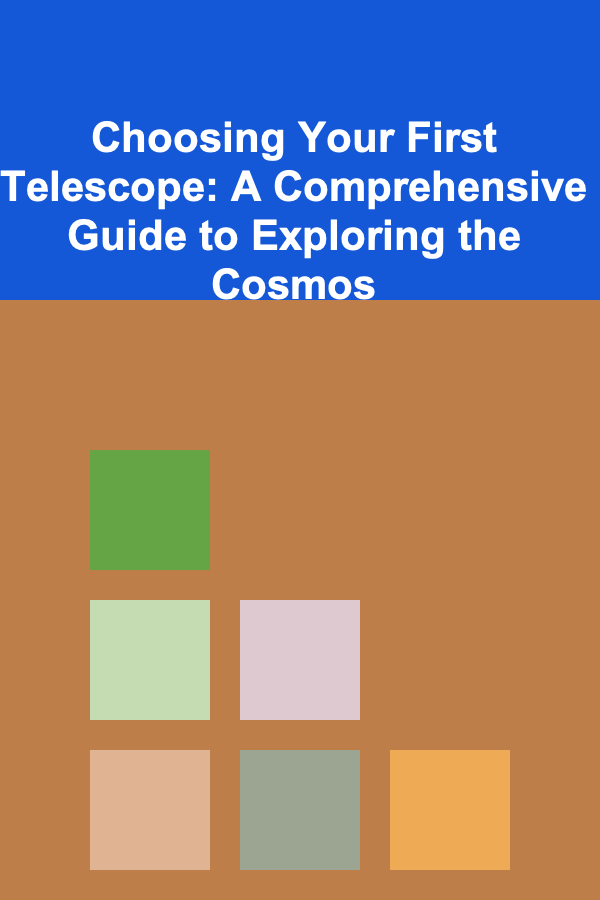
Choosing Your First Telescope: A Comprehensive Guide to Exploring the Cosmos
ebook include PDF & Audio bundle (Micro Guide)
$12.99$11.99
Limited Time Offer! Order within the next:

Embarking on a journey into astronomy is an exciting endeavor. The night sky, with its myriad stars, planets, and nebulae, holds an irresistible allure. Choosing your first telescope can feel daunting, but with a little knowledge and careful consideration, you can select an instrument that opens up a universe of possibilities. This guide provides a detailed overview of the key factors involved in selecting a telescope that suits your needs, budget, and aspirations. We will cover different types of telescopes, important specifications, considerations for mounts, and practical advice for beginners.
Understanding the Fundamentals: What Makes a Telescope Work?
Before diving into specific models, it's essential to understand the fundamental principles behind how telescopes function. A telescope's primary purpose is to gather light. The more light it gathers, the fainter the objects you can see, and the more detail you can resolve. This light-gathering ability is directly related to the aperture of the telescope -- the diameter of its primary light-collecting component (either a lens or a mirror).
Telescopes also magnify the image, making objects appear larger. However, magnification is often overemphasized. High magnification without sufficient light-gathering power results in a blurry, dim image. A smaller, brighter image with good contrast is far more desirable than a large, dim, and fuzzy one. The focal length of the telescope and the focal length of the eyepiece determine the magnification: Magnification = Telescope Focal Length / Eyepiece Focal Length. For example, a telescope with a 1000mm focal length used with a 10mm eyepiece will yield a magnification of 100x.
Finally, a telescope's ability to resolve fine details is known as its resolving power. This is also directly related to the aperture. A larger aperture allows you to see finer details, such as the rings of Saturn or the cloud bands on Jupiter. Think of it like this: larger aperture = more light = more detail.
Types of Telescopes: Refractors, Reflectors, and Catadioptrics
Telescopes are broadly classified into three main types based on their optical design:
Refractor Telescopes
Refractors use lenses to gather and focus light. They are often praised for their sharp, high-contrast images and are well-suited for observing planets, the Moon, and double stars. Refractors are typically more expensive per inch of aperture than reflectors.
Advantages of Refractors:
- Excellent image quality: Refractors typically produce sharp, high-contrast images with minimal diffraction.
- Sealed tube: The sealed tube protects the optics from dust and moisture, reducing the need for frequent cleaning.
- Low maintenance: Generally require less maintenance than reflectors.
- Good for planetary and lunar observation: Excel at revealing fine details on bright, high-contrast objects.
Disadvantages of Refractors:
- Smaller aperture for the price: Refractors tend to be more expensive for a given aperture compared to reflectors.
- Chromatic aberration: Some refractors, particularly achromatic refractors, can suffer from chromatic aberration (color fringing) around bright objects. Apochromatic (APO) refractors minimize this, but are more expensive.
- Can be bulky and long: Longer focal lengths are needed for higher magnification, leading to longer telescope tubes.
Reflector Telescopes
Reflectors use mirrors to gather and focus light. They offer the largest aperture for a given price, making them ideal for observing faint deep-sky objects such as galaxies and nebulae. The most common type of reflector is the Newtonian reflector, which uses a parabolic primary mirror and a smaller secondary mirror to direct the light to the eyepiece on the side of the telescope tube.
Advantages of Reflectors:
- Larger aperture for the price: Reflectors offer the best value for money in terms of aperture.
- No chromatic aberration: Mirrors don't suffer from chromatic aberration, resulting in accurate color rendition.
- Good for deep-sky observing: The large aperture allows you to see fainter objects.
Disadvantages of Reflectors:
- Open tube: The open tube allows dust and moisture to enter, requiring periodic cleaning and collimation (alignment of the mirrors).
- More maintenance: Requires collimation, which can be a daunting task for beginners.
- Central obstruction: The secondary mirror obstructs some of the incoming light, reducing contrast slightly.
Catadioptric Telescopes
Catadioptric telescopes combine lenses and mirrors to achieve a compact design with a long focal length. The two most common types are Schmidt-Cassegrain (SCT) and Maksutov-Cassegrain (MAK) telescopes. They are versatile instruments suitable for both planetary and deep-sky observing. They are popular for their portability and ease of use.
Advantages of Catadioptric Telescopes:
- Compact and portable: The folded optical path results in a shorter tube length, making them easier to transport and store.
- Versatile: Suitable for both planetary and deep-sky observing.
- Sealed tube (mostly): Helps protect the optics from dust and moisture.
Disadvantages of Catadioptric Telescopes:
- More expensive than reflectors for the same aperture: They are generally more expensive than reflectors.
- Central obstruction: The secondary mirror obstruction is relatively large, which can reduce contrast slightly.
- Can require cooling down: The enclosed tube can take time to reach thermal equilibrium with the ambient temperature, affecting image quality.
Key Specifications to Consider
Beyond the type of telescope, several specifications directly influence its performance. Paying attention to these details will help you make an informed decision.
Aperture
As mentioned earlier, aperture is the most crucial specification. It determines the light-gathering power and resolving power of the telescope. A larger aperture allows you to see fainter objects and finer details. For a beginner, a minimum aperture of 70mm for a refractor or 114mm for a reflector is recommended. A 6-inch (150mm) or 8-inch (200mm) reflector provides significantly better performance for observing deep-sky objects.
Focal Length
The focal length determines the magnification potential of the telescope. A longer focal length results in higher magnification with the same eyepiece. However, as discussed, high magnification is not always desirable. A moderate focal length is generally more versatile.
Focal Ratio (f/number)
The focal ratio is the focal length divided by the aperture (f/number = Focal Length / Aperture). A lower f/number (e.g., f/5) indicates a "fast" telescope, which is better suited for astrophotography and wide-field views. A higher f/number (e.g., f/10) indicates a "slow" telescope, which is better suited for high-magnification views of planets and the Moon.
Magnification
While magnification is important, it is often overemphasized. The useful magnification of a telescope is limited by its aperture and the atmospheric conditions (seeing). A good rule of thumb is that the maximum useful magnification is about 50x per inch of aperture. Exceeding this limit will result in a blurry image.
Mount
The mount is the foundation of the telescope. It provides stability and allows you to point the telescope at different objects in the sky. The mount is just as important as the telescope itself. A shaky or unstable mount will make observing frustrating.
Types of Mounts: Alt-Azimuth and Equatorial
Telescope mounts come in two main types: Alt-Azimuth and Equatorial.
Alt-Azimuth Mounts
Alt-Azimuth (Alt-Az) mounts move in two axes: altitude (up and down) and azimuth (left and right). They are simple to use and intuitive for beginners. Many beginner telescopes come with Alt-Azimuth mounts. Dobsonian telescopes use a simple Alt-Azimuth mount that is very stable and easy to move, even for large apertures.
Advantages of Alt-Azimuth Mounts:
- Simple to use: Intuitive movements make them easy to learn.
- Lightweight and portable: Generally lighter and more portable than equatorial mounts.
- Good for terrestrial viewing: Suitable for observing objects on Earth as well as in the sky.
- Dobsonians offer large aperture at a reasonable cost.
Disadvantages of Alt-Azimuth Mounts:
- Not ideal for astrophotography: Objects drift out of the field of view due to Earth's rotation, requiring constant manual adjustments.
- Requires manual tracking: You need to manually adjust the telescope to follow objects as they move across the sky. Unless computerized.
Equatorial Mounts
Equatorial mounts are designed to compensate for Earth's rotation. One axis (the polar axis) is aligned with the North Celestial Pole, allowing you to track objects by rotating the telescope around a single axis. This is essential for astrophotography.
Advantages of Equatorial Mounts:
- Easy tracking: Once properly aligned, you can track objects by rotating the telescope around a single axis.
- Suitable for astrophotography: Allows for long-exposure photography of celestial objects.
Disadvantages of Equatorial Mounts:
- More complex to set up: Requires polar alignment, which can be challenging for beginners.
- Heavier and more expensive: Generally heavier and more expensive than Alt-Azimuth mounts.
- Can be less intuitive to use: The movements can be confusing for beginners.
Computerized (Go-To) Mounts
Both Alt-Azimuth and Equatorial mounts can be computerized, also known as Go-To mounts. These mounts have a built-in computer that can automatically point the telescope at thousands of celestial objects. Go-To mounts are convenient and save time, but they require a power source and can be more expensive.
Choosing the Right Eyepieces
Eyepieces are lenses that you look through to view the image formed by the telescope. They come in different focal lengths, which determine the magnification. A good set of eyepieces is essential for getting the most out of your telescope.
Key considerations when choosing eyepieces:
- Focal Length: Shorter focal lengths provide higher magnification, while longer focal lengths provide lower magnification. A range of eyepieces with different focal lengths is recommended. A good starting set would include a 25mm, 10mm, and possibly a 6mm eyepiece.
- Apparent Field of View (AFOV): The AFOV determines the width of the view you see through the eyepiece. Wider AFOVs (e.g., 60 degrees or more) provide a more immersive viewing experience.
- Eye Relief: Eye relief is the distance from the eyepiece lens to where your eye needs to be to see the entire field of view. Longer eye relief is more comfortable, especially for eyeglass wearers.
Essential Accessories
Besides eyepieces, several other accessories can enhance your observing experience.
- Finderscope: A small, low-magnification telescope attached to the main telescope, used to help you locate objects in the sky. A red dot finder is a simpler alternative.
- Barlow Lens: A lens that doubles or triples the magnification of any eyepiece.
- Filters: Filters can enhance the contrast of certain objects, such as planets or nebulae.
- Star Charts and Planispheres: Helpful tools for learning the constellations and locating objects in the sky. There are also many excellent astronomy apps for smartphones and tablets.
- Red Flashlight: Preserves your night vision while allowing you to see your equipment.
Budget Considerations
Telescopes range in price from a few hundred dollars to tens of thousands of dollars. It's important to set a budget and stick to it. Remember that it is better to have a smaller aperture telescope on a sturdy mount than a large aperture telescope on a wobbly one. For a beginner, a good quality telescope can be obtained for around $300 - $600. Consider buying used equipment as well; there are many reputable sources of used telescopes that are in excellent condition.
Where to Buy a Telescope
You can purchase telescopes from various sources, including:
- Specialty Astronomy Stores: Offer expert advice and a wide selection of telescopes and accessories.
- Online Retailers: Provide a convenient way to shop, but be sure to read reviews and compare prices.
- Used Equipment Markets: Can be a good way to save money, but inspect the equipment carefully before buying.
Practical Advice for Beginners
Here are some practical tips to help you get started with your new telescope:
- Start with Low Magnification: It's easier to find objects at low magnification.
- Practice During the Day: Get familiar with your telescope's controls and how to focus it during the day before trying to use it at night.
- Find a Dark Sky Location: Light pollution can significantly reduce the visibility of faint objects. Try to find a dark sky location away from city lights.
- Let Your Eyes Adjust to the Dark: It takes about 20-30 minutes for your eyes to fully adapt to the dark. Avoid looking at bright lights during this time.
- Join an Astronomy Club: Astronomy clubs are a great resource for learning about astronomy and getting advice from experienced observers.
- Be Patient: Astronomy takes time and patience. Don't get discouraged if you don't see everything you expect to see right away.
- Keep Records: Record your observations in a notebook. Include the date, time, location, telescope used, eyepiece used, and any notes about what you saw.
What to Observe with Your First Telescope
Here are some popular objects to observe with your first telescope:
- The Moon: A fascinating object to observe with craters, mountains, and valleys.
- Planets: Venus, Mars, Jupiter, and Saturn are all visible with a small telescope. You can see the phases of Venus, the polar ice caps on Mars, the cloud bands and moons of Jupiter, and the rings of Saturn.
- Double Stars: A beautiful sight to observe, even with a small telescope.
- Open Star Clusters: Collections of stars that are gravitationally bound together.
- Globular Star Clusters: Densely packed spheres of stars that orbit the center of our galaxy.
- Nebulae: Clouds of gas and dust where stars are born.
- Galaxies: Vast collections of stars, gas, and dust that are located far outside our own Milky Way galaxy.
Conclusion
Choosing your first telescope is an exciting step towards exploring the wonders of the universe. By understanding the different types of telescopes, key specifications, mounts, and accessories, you can make an informed decision that suits your needs and budget. Remember to start with realistic expectations, be patient, and enjoy the journey of discovery. Happy stargazing!

How to Declutter Your Family Room in One Weekend
Read More
How to Measure the Success of Your Event Sponsorships
Read More
How to Use Color-Coding to Organize Bookshelves
Read More
How to Use Rolling Carts for Mobile Storage Solutions
Read More
How to Use Rugs and Curtains to Reduce Noise in Your Home
Read More
How to Find Your Spark Again
Read MoreOther Products

How to Declutter Your Family Room in One Weekend
Read More
How to Measure the Success of Your Event Sponsorships
Read More
How to Use Color-Coding to Organize Bookshelves
Read More
How to Use Rolling Carts for Mobile Storage Solutions
Read More
How to Use Rugs and Curtains to Reduce Noise in Your Home
Read More